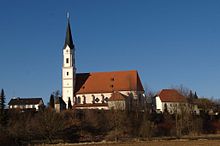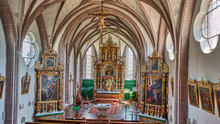Assumption of Mary (Kirchdorf am Inn)
The Roman Catholic parish church of the Assumption of Mary is a late Gothic hall church in Kirchdorf am Inn in the Lower Bavarian district of Rottal-Inn . It belongs to the parish of the Assumption of Mary Kirchdorf am Inn in the dean's office Simbach in the diocese of Passau .
history
The church, built around 1500, is one of the most important late Gothic churches in the region. It can be assumed that experts from the Bauhütte in Braunau am Inn (possibly Wolfgang Wiser ) were involved in the construction, which is indicated by original details of the external structure and the vault figures. The construction of the church was sponsored by a brotherhood of boatmen. In the years 1971–1973 a restoration was carried out, in which extensions were added on the south side.
architecture
Exterior
A continuous roof closes the choir and nave together. Like the west gable wall, the north side was built from tuff stone blocks , the south side from plastered brick masonry. The whole structure is provided with buttresses. A carefully crafted water hammer and a sill cornice on the choir structure the building. What is striking is the decorative shape of the rod profiles inserted through them. The west tower has moved from its axis to the south, has been completely plastered and has been changed several times. The additions on the south side ( portico , sacristy and choir side chapel) were added during the restoration. The inner south portal has a pointed arch with richly profiled tuff stone walls , similar to that in the Erlach church .
Interior
The interior is harmoniously proportioned and shows the hall-like room unification that was carried out in the late Gothic and especially in this region. The four-bay nave is provided with pointed wall pillars. The choir, which is only slightly drawn in, is divided into two yokes with five-eighths ending. Both parts of the room have flat shield arches and an almost barrel-shaped ribbed vault, the artistic rib figures of which refer to Wiser. Particularly typical is the use of arched ribs, which in the ship cause a flowing movement in the central axis, which is achieved by alternating opposite arches and by winding crossings.
Similar to the central nave of the parish church of Braunau am Inn , the ribbed stars in the choir vault are optically flexible thanks to curved intermediate ribs . Only at the end of the choir are four small plate-shaped keystones attached. The semicircular templates of the services are provided with polygonal capitals in the nave, with rustic busts of prophets in the choir. Most of the windows are simply ogival or were partially redesigned later in a four-pass shape. The west gallery dates from the turn of the 18th and 19th centuries. The colored version of the room was reconstructed during the last restoration and emphasizes the structure in brownish-purple ashlar on a white background. The sacristy door is equipped with rich late Gothic fittings.
Furnishing
The high altar is a work by Schärdinger carpenter Stephan Tabor from 1689. The magnificent, flat baroque retable is divided into two three-part, similarly designed floors, which are provided with twisted, entwined columns as well as beams and cheeks made of acanthus . Most of the carved figures come from the late Gothic period and were later recast. In the main niche there is a valuable seated figure of Our Lady , whose rich robe is gathered by two angels. In the side niches there are standing figures of Saints Barbara and Catherine , which come from the same former altar. The side figures of the altar extract represent the apostles Peter and Paul . The central figure from the 17th century shows St. Nicholas . The angels on the gables were created in 1689 by Sebastian Hagenauer from Schärding.
The side altars from the mid-17th century are flat reredos made as counterparts with cartilage decorations . The paintings show the Holy Family and the baptism of Christ . Two associated Lent cloths from 1625 show the Seven Sorrows of Mary and a depiction of Ecce homo , which are exhibited in the side chapel. The font from 1530 is a twelve-sided red marble basin. The corresponding wooden lid in the form of a high polygonal tent roof is crowned by a wooden statuette of John the Baptist . The organ is a work by Michael Weise from 1973 with 17 stops on two manuals and pedal .
literature
- Georg Dehio : Handbook of the German art monuments. Bavaria II - Lower Bavaria. Deutscher Kunstverlag, Munich, Berlin 2008, ISBN 978-3-422-03122-7 . Pp. 251-253.
Web links
Individual evidence
- ↑ Information about the history on the website of the parish. Retrieved November 26, 2018 .
- ↑ Information about the organ on the organ database Bavaria online. Retrieved August 25, 2020 .
Coordinates: 48 ° 14 ′ 33.3 " N , 12 ° 58 ′ 51.8" E






